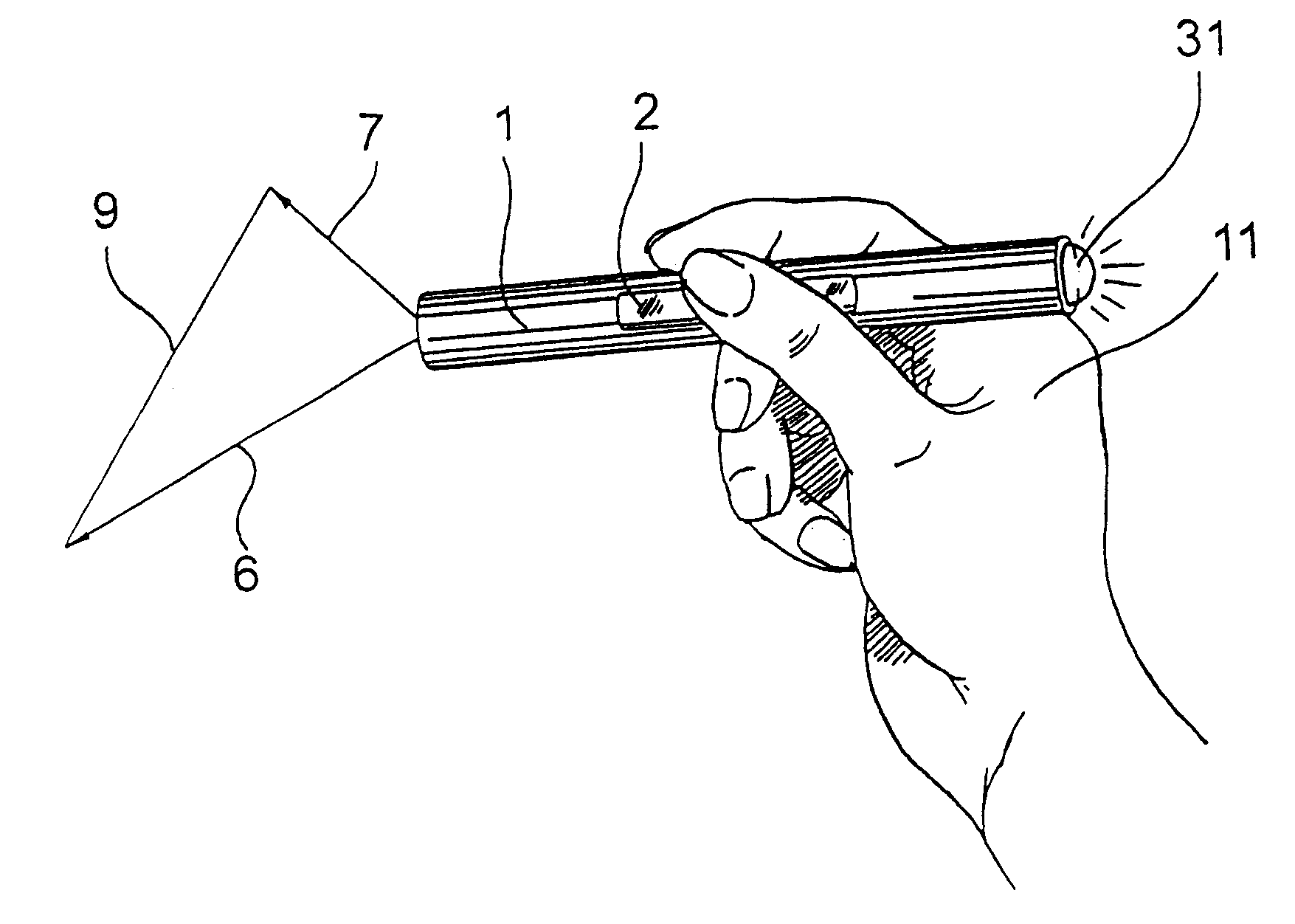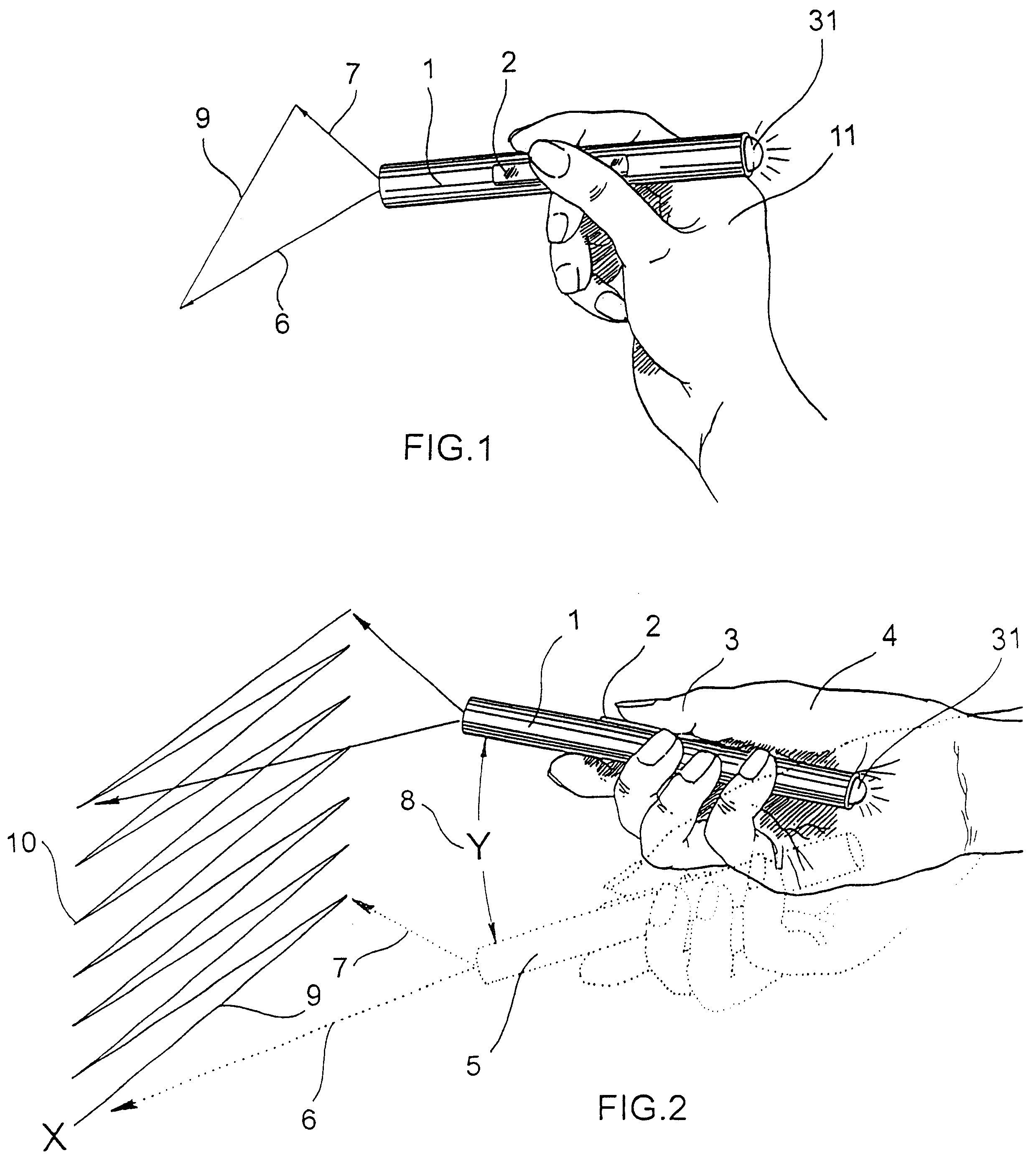It is light, rugged and easy to hold, but its use is confined to reading smooth flat surfaces with relatively high quality printed bar-code.
Because of this short
focal length the device has virtually no
depth of field and a major drawback of being essentially limited to contact reading.
Surface damage often results in many repeated reading attempts as well as poor productivity.
Contact-type scan wands are also poorly suited to scanning printed material that has damage (as coupons usually do when carried around in a purse), or when the surface that is labeled or printed upon is curved, soft, irregular or wrinkled such as mailing pouches, or with other generally non-flat surfaces upon which bar-code is printed.
Consequently, these are more effective for reading bar-codes printed on irregular surfaces, but have the drawback of being far bulkier than contact wands.
The gun-type scanners have ergonomic characteristics similar to those of a hand gun, yet are generally bulkier; in many cases, they are more like a hand-held hair dryer and are not amenable to being carried in a pocket or to storage in a cash drawer.
The aim and
shoot characteristics of the gun-type device are suited for long range bar-
code reading on the order of a few feet, but remain clumsy for short range reading jobs where distances of about six inches to one foot are involved, especially when the user is seated at a
desk or counter.
In such cases, the ergonomic benefits are lost and become liabilities.
Because of its size and handling requirements, numerous problems associated with the pistol-grip aim and
shoot design result.
With these functional demands placed on the user, difficulty of operation increases significantly with any physiological impairments or severance of digits the operator may have.
Of course, users with substantial disability impairing their ability to grip at all, are entirely precluded from using aim and
shoot type pistol grip devices.
Because of its weight, dimensions and triggering
mechanics, other methods of holding and moving the device without using the hand and fingers to grip and manipulate are ungainly.
Pistol grip aim and shoot scanners create special problems for users with disabilities, and reasonable
accommodation problems for employers under the new Americans with Disabilities Act.
Another problem is realized when observing the extent to which an able-bodied user's gripping hand is monopolized by the holding and operation of the gun.
This can
cut into productivity significantly and impede the flow of work.
Another problem associated with aim and shoot devices is that they typically require operators working at counters to pull their using arm back at the
elbow so that the end of the gun clears the surface of the
label they are attempting to scan.
Apart from being unsound from a general human factors viewpoint, this extra movement can create discomfort for people with
arthritis,
bursitis,.and other diseases, injuries or disabilities affecting the articulations of the shoulder.
The problem is worsened if the operator needs to be seated at a counter.
The very shape of gun-type scanners can
pose safety concerns in some instances, such as an employee working on a late shift in a warehouse carrying and using the gun, wherein contract security personnel might become unduly alarmed by the pistol-like appearance, especially when observed at a distance.
This is extremely difficult, since bar-code labels are typically about the size of a large
postage stamp.
Also, relatively minor curves in the
scan line caused by the amplification of normal hand movement as a function of target distance may throw off the time values assigned to each element of the bar code and result in a bad scan.
Repeated attempts are more and more likely to be poor as well, as the result of natural hand-arm fatigue and
frustration.
This device was therefore not very successful commercially.
The fingers are freed from the arresting level of involvement required to operate a pistol-grip mechanism, yet the design is nonetheless ungainly because the back of the hand is not well-suited to aiming the beam.
Generally, CCD readers must be placed on top of and cover the target bar-code, have poor
depth of field and are limited as to the size of bar-codes to be read, and thus possess many of the limitations of contact readers.
Experimental CCD systems with expensive large lens focusing systems can achieve modest improvements in the
depth of field, but are bulkier and expensive.
Owing to a complex
optical path with ample head room requirements for the beam to escape, these scanners are bulky and at best may be packaged in boxes or gun shaped housings, but not smaller.
Because of the size of the motors required, this
system is ill suited to hand-held scanners.
It has a limited range of scan patterns, all of which include a significantly curved path of the moving beam; it cannot produce a line or
raster scan.
Also, because of motor
inertia, this
system is ill suited to the intermittent operation characteristic of a hand-held
scanner.
Existing fixed
mount scanners are not amenable to mounting on
robot arms for use on production lines because of their size and weight.
Reluctance of employees to accept new bar-code scanning applications because of the clumsiness or inconvenience of the equipment is also an important issue.
For example, nurses, in the course of their
patient care duties, have been resistant to the idea of using bulky bar code readers because of the clumsiness and inconvenience of the devices.
Other problems with prior art devices stem from the inability to
mount them in tiny housings because of the space consuming clearance requirements associated with non-axial optical designs.
Even so this scan engine is too bulky to fit into a pen-size housing and cannot produce two dimensional scan patterns.
It suffers from the common optical
layout problem of having to provide ample head room for the emerging scan beam.
None of the known moving beam or CCD scanning systems which can automatically scan one or two dimensions in order to read information is small enough to be packaged into a housing having the general size and shape of a pen or wand.
 Login to View More
Login to View More  Login to View More
Login to View More 


